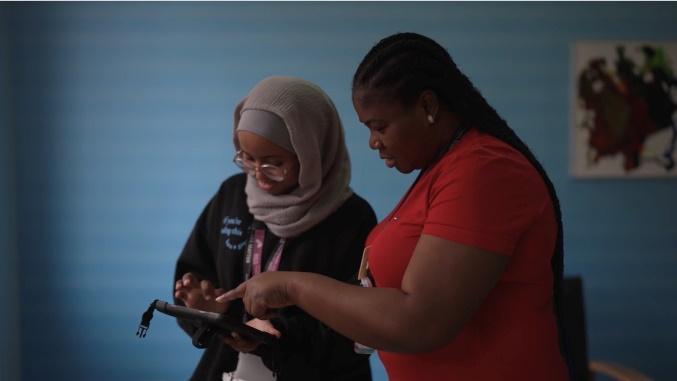“I am a dreamer,” says one such ‘guerrilla’, Alberto Escudero-Pascual, a Spanish-born researcher at the Kista IT University near Stockholm. “I like trying out new things.” He clambers up a 30-metre radio mast next to an old ski building and fits a dish to the top. From there he can see for 40 kilometres, spotting villages and isolated holiday homes far off in the distance. Most of the villages are in range of the dish, and each house contains a potential subscriber to his service.
Escudero-Pascual, who has also rigged up a similar wireless network at his university campus, is the leader of a non-profit organisation that is installing wireless local area network (W-LAN) equipment throughout the region. Anyone with a laptop computer and W-LAN plug-in card, which cost around €150, can access the web at speeds of up to 11Mbit/sec, provided they are in range. The network organisers also plan to trial voice-over-IP technology, allowing users to make free voice calls, once they have acquired a VoIP ‘gateway’ to connect the W-LAN to the phone network.
Tech brief: Wi-Fi
802.11b, or Wi-Fi, is the most popular form of wireless local-area networking. It typically allows data transfer at speeds of up to 11Mbit/sec over a range of about 150 metres, although this can be boosted with special equipment. The specification is part of the Institute of Electrical &Electronics Engineers’ networking standard, which includes ethernet, that was drawn up by IEEE committee 802. It took off when Apple Computer introduced its Airport technology, based on Lucent’s 802.11b cards and base stations, into its complete line of desktop and portable computers in 1999. Today, most vendors of networking equipment – including Intel, Buffalo, Netgear, Cisco and Linksys – are producing Wi-Fi cards and receiver equipment (base stations).
To equip a computer with Wi-Fi, all that is needed is an additional card or a free USB port and the correct software. Since Wi-Fi uses a variant of the ethernet protocol, Windows networking, TCP/IP and other standard network systems are compatible with it. Thus, a Wi-Fi equipped computer can communicate with computers and peripherals on a standard wired LAN, provided there is a base station connected to the LAN to act as a bridge between the wired and wireless systems. In the home, a Wi-Fi base station will typically contain a modem and/or an ethernet port to connect wireless computers to the Internet via a phone line or DSL connection.
Wi-Fi devices can also communicate directly with other wireless devices to create ‘ad hoc’ networks, in a similar manner to devices using the Bluetooth-branded wireless personal area networking technology.
Bluetooth cannot compete with Wi-Fi on range or speed, lessening its appeal to businesses. On the other hand, Wi-Fi’s high power consumption makes it unsuitable for embedding in small devices such as mobile phones. More versions of 802.11, offering higher speeds, power control and dynamic frequency allocation, are in the pipeline. The worry, however, is that different regions of the world will adopt different standards, fuelling fears that W-LAN will suffer from the same compatibility issues that dogged the roll-out of digital cellular networks.
Spare Capacity
The existing service is made possible by siphoning off spare capacity from the digital subscriber line (DSL) connections supplied by Telia, the dominant Swedish carrier, to several local companies that sponsor the scheme. Perhaps surprisingly, Telia, which has a W-LAN business of its own, does not seem too concerned by the new competition. In a meeting in January 2002, Telia executives assured Escudero-Pascual that he can continue expanding his network – but only on the condition that he agrees not to charge users.
“This is right on the border of what is legal today,” he admits. It is a fact not lost on the industry. Network operators’ legal teams are studying the terms of their standard broadband-connection sales contracts to ensure that any loopholes are closed regarding the distinction between ‘sharing’ and ‘reselling’ bandwidth. In addition, virtually every national regulatory authority in the European Union (EU) is now looking at whether they need to extend restrictions over such use of the airwaves, under pressure from operators, or relax them, under pressure from the W-LAN community (see Tech brief: Wi-Fi).
‘Broadband guerrillas’ are scarce in Europe, but others do exist, often coordinating peer-to-peer (P2P) arrangements whereby DSL subscribers share bandwidth by setting two-way antennae, or ‘nodes’, that allow for transmission as well as reception of data. Elsewhere, some providers are applying sophisticated wireless direct-marketing techniques to alert visitors of their service the moment they come in range.
James Stevens and Julian Priest, two London-based technology entrepreneurs, are overseeing the expansion of a P2P-style network across the UK capital. Visitors to the project’s web site, consume.net, can find a nearby node with which to communicate simply by tapping in their postcode or street name. There are reports of similar wireless-networking projects underway in Germany and Spain.
But while the kind of project being led by Escudero-Pascual in Sweden is what one might expect of Scandinavia, where innovations in wireless technology were nurtured during the 1980s and 1990s, it was in US neighbourhoods in 1998 and 1999 that the first community W-LANs emerged. Indeed, the ‘broadband guerrilla’ proposition is one of the few examples in the wireless industry of a US-led revolution, fuelled by more lenient regulations than in the EU.
In San Francisco’s Presidio, a former military base turned public park, for example, several antennae have been placed on ex-military buildings by technology entrepreneur Brewster Kahle, enabling park visitors to surf wirelessly from their laptops. Guerrilla Net, a shadowy group of IT-security experts from the Boston area, have set up networks in Cambridge and other well-heeled areas of Massachusetts. In Seattle, Real Networks systems administrator Matt Westerveldt coordinated the building of a free network for residents of the city’s Capitol Hill suburb, where Scott Kennedy, a former Microsoft engineer turned Internet café owner, used an empty tube of Pringles crisps as a makeshift antenna to boost download speeds for his customers. Other ‘guerrilla networks’ have sprung up in Aspen, Colorado and Portland, Oregon.
But most compelling, perhaps, is the tale of Anthony Townsend and Terry Schmidt, two 20-something programmers who co-founded NYCWireless, a non-profit group coordinating the rollout of W-LANs across New York. The scheme, begun in 2000, came into its own following the devastating attacks on the city on 11 September 2001.
Relying on powerful add-on antennae to propel signals over longer distances than is usual for W-LANs, they envisioned reconnecting dozens of lower Manhattan companies that lost web access in the wake of the terrorist atrocities. Poignantly, their efforts were largely in vain: most companies in the area could not be reached by phone or email to be told of the service.
A threat to 3G?
While some networks are run by ‘guerrilla’ enthusiasts for their local communities, the vast majority of the estimated 2,000 public W-LANs in the world have been installed by commercial service providers, such as Jippii of Finland and SkyNetGlobal of Australia, and a small number of incumbent operators, such as Telia and Deutsche Telekom-backed Voicestream of the US. These networks serve so-called ‘hotspots’ in airports, coffee shops, hotel lobbies and conference centres.
p> Since the first W-LANs were built, questions have inevitably been raised about the consequences for the business case of 3G, or the third generation of cellular networks.
Telecoms consultancy BWCS recently spelt out the threat to carriers. It suggested the number of W-LAN business users would outnumber 3G business users by 130 million to 90 million in 2006. Places where once it was assumed that 3G business users would run up large bills – in that ‘grey time’ away from the office in, say, an airport departure lounge – are the very same areas where commercial W-LANs are already in situ. 3G coverage is unlikely to reach these ‘hotspots’ before 2003, by which time it may be too late.
But the situation may be less gloomy for incumbents than this suggests. Some sources argue that impromptu W-LANs help to drive the wider market, which operators will eventually dominate. And there is a further school of thought that says that incumbent operators, most of which have 3G businesses, are indirectly generating additional revenue from the creation of such community networks, since service providers and ‘guerrillas’ are heavy users of broadband connections.
In addition, help may be at hand from industry regulators. W-LANs may operate in supposedly unrestricted parts of the radio spectrum, but in practice they are not permitted everywhere. According to the European Radiocommunications Office, public W-LANs are illegal in the UK, Italy, Spain, Portugal, Luxembourg, Latvia and Estonia – notwithstanding the existence of guerrilla networks in some of those countries, whose operators run the risk of having their equipment seized and face fines or even imprisonment. Indeed there have been cases of public W-LANs that were refused permission in the UK – Wayport, a leading US W-LAN service provider, had to take down a network in a hotel in London’s Docklands area, while Telia failed to persuade the UK’s Radiocommunications Agency to allow it to build a network at Heathrow Airport.
Even in those countries that do permit public W-LANs, many do not allow service providers to charge users. But these and other restrictions are currently being reviewed by a number of national regulators, and changes could come into force as early as summer 2002.
‘Recreating 3G’: the technical issues
The worst-case scenario for 3G network operators is that separate wireless LANs operated by commercial service providers and ‘broadband guerrillas’ will one day be linked together to create a single, nationwide network. Such a ‘super-W-LAN’ could provide optimum speeds more than five times those of 3G, and access fees would almost certainly be lower. 3G operators could never hope to get a payback on their investments in licences and network infrastructure, and many would go under.
But how likely a scenario is this? Leaving aside the various regulatory obstacles, which are discussed in the adjacent main article, technical experts say that connecting different W-LANs is theoretically possible. But every network would have to use the same W-LAN technology, or at least mutually-compatible technologies. At present there are several W-LAN standards in use – and yet more are on the way.
Network software would have to be developed to allow the seamless ‘handover’ between W-LAN systems. Further applications would be required capable of identifying and authenticating another W-LAN service provider’s subscriber, establishing that user’s billing regime, and then alerting a settlement house to take care of the invoice.
Excilan, a Luxembourg-based W-LAN services company, argues that providers should explore so-called ‘roaming’ agreements as a way to maximise revenue. But it concedes: “Seamless roaming can only be achieved when the service providers agree on how to interact and how to achieve back-office transparency so as to minimise the cost of services while at the same time offering consistent user experience.” That is likely to be a mammoth task.
In theory, networks could just as well be liberalised as restricted further. Clearly, there is commercial pressure to limit their use. Incumbent and new-entrant carriers paid out a combined €160 billion for the right to operate 3G networks in European countries for the next 15-20 years – and can be expected to invest at least the same amount again in testing and building the networks and marketing the new services. Many are now saddled with huge debts, and have seen investor sentiment turn against them. They now feel the governments that sold the licences owe them something in return.
One idea being propagated within some sections of the operator community is for W-LANs to be moved from the present 2.4GHz band to the 5GHz band used by military radar and satellite uplinks. Proponents argue that the 2.4GHz band is becoming increasingly congested – Bluetooth technology, microwave ovens, baby monitors and garage-door openers are among numerous applications that use similar frequencies – while introducing a retrospective licensing scheme for 2.4GHz would be unworkable, they say. Instead, licences would be issued only for W-LANs at 5GHz.
But this plan has its detractors. Military commanders are believed to oppose giving over yet more radio space to civilian use, while some experts suggest that W-LANs would interfere with satellite connections, prompting scare stories of spacecraft brought crashing back to Earth.
One compromise being studied by regulators is for W-LANs to be available at both 2.4GHz and 5GHz, but only those operating at 5GHz would be licensed. Under this mooted plan, licence conditions would specify that a particular W-LAN can operate only in a strictly defined area – such as within a specific hotel – thereby removing the incumbents’ biggest fear: that one day W-LANs will overlap to create a city-wide or even a national high-speed network (see Recreating 3G – the technical issues).
In any case, national governments themselves, and by extension their local regulators, are probably following a different agenda. Their desire to create ‘broadband societies’ could ultimately lead to more of the airwaves being given over for unregulated W-LANs, with service providers allowed to charge users if they wish. They will be mindful, too, that the EU risks falling further behind the US in the markets for W-LAN equipment manufacturing and application development if it fails to bring its regulations in line with those of the US.
Whatever the outcome of the present arguments, the powerful operator community is determined to protect its 3G investment. 3G sceptic Arto Karila, an advisor to several wireless start-ups and a former professor at Helsinki University of Technology, is not surprised. “You should never underestimate the ability of telcos to hit back,” he says. “Those people can be quite ruthless.”
It is a view shared by Philip Bates, executive VP and UK general manager of W-LAN software company Bluesocket. The US-based company, he says, originally intended to set itself up in business as a W-LAN service provider. It retreated from those plans when it became clear that it would be difficult to raise money for such a project, given the high cost of building a network and acquiring customers as well as the risk of going up against powerful incumbents, with their existing client base, infrastructure and billing systems. “We felt that it made a very difficult business case,” he says.
In a possible sign of things to come, Voicestream, one of the biggest US wireless operators, bought several hundred W-LANs from MobileStar, previously the world’s biggest W-LAN operator, in November 2001.
MobileStar evidently found it a difficult business, overstretching itself and running out of cash, eventually filing for bankruptcy protection. Another W-LAN service provider in the US, Metricom, also filed for bankruptcy protection in 2001.
Many incumbent operators dismissed the threat of W-LANs when the technology emerged in the late-1990s. The growing feeling now, however, is that if they are prepared to cast off that complacency, they still have time to defeat upstart W-LAN service providers and thus consign the ‘broadband guerrilla’ phenomenon to a footnote in technology history.










